This post may contain affiliate links. Please read our disclosure policy.
This soft gluten free flatbread is perfect for wraps, gyros, and mini pizzas—and made with just five pantry staples plus salt. Use plant-based milk to make it fully vegan.
I often double or triple the recipe, portion the dough, and refrigerate it. Then I can roll, cook, and serve fresh flatbread any night of the week.

“These are AMAZING! They are going to be a regular part of the rotation for sure. They were super easy to make and came out so well. Thank you thank you thank you! Even gluten-eaters loved them, and we all know that’s the truest test!”
my take
Nicole's Recipe Notes
- Quick and easy: 5 ingredients in a single bowl, mixed together, chilled if you have time, rolled out and cooked in a skillet.
- Texture: Soft, flexible, and chewy, these flatbreads are really unique.
- Versatile: Perfect for a turkey sandwich, or heat them to make burritos, gyros, and miniature pizzas.
- No yeast needed: Skip rise time entirely—perfect if you’re sensitive to yeast or just short on time.
- Refrigerator-friendly: The dough stores well for days—just roll and cook as needed.

Recipe ingredients
- Gluten free flour blend: The base of this recipe is a high quality all purpose gluten free flour blend like Better Batter or Nicole's Best. If your blend doesn't already have xanthan gum, be sure to add it.
- Tapioca starch/flour: Helps create more of a stretchy, pliable flatbread than just an all purpose gf flour blend alone.
- Baking powder: Just a little bit helps create those bubbles that form on the bread.
- Salt: Makes them so much more flavorful.
- Olive oil: Adds flavor, richness, and tenderness.
- Milk: Use unsweetened nondairy milk for vegan flatbread. Avoid nonfat milk—whether dairy or not—for best texture and flavor.
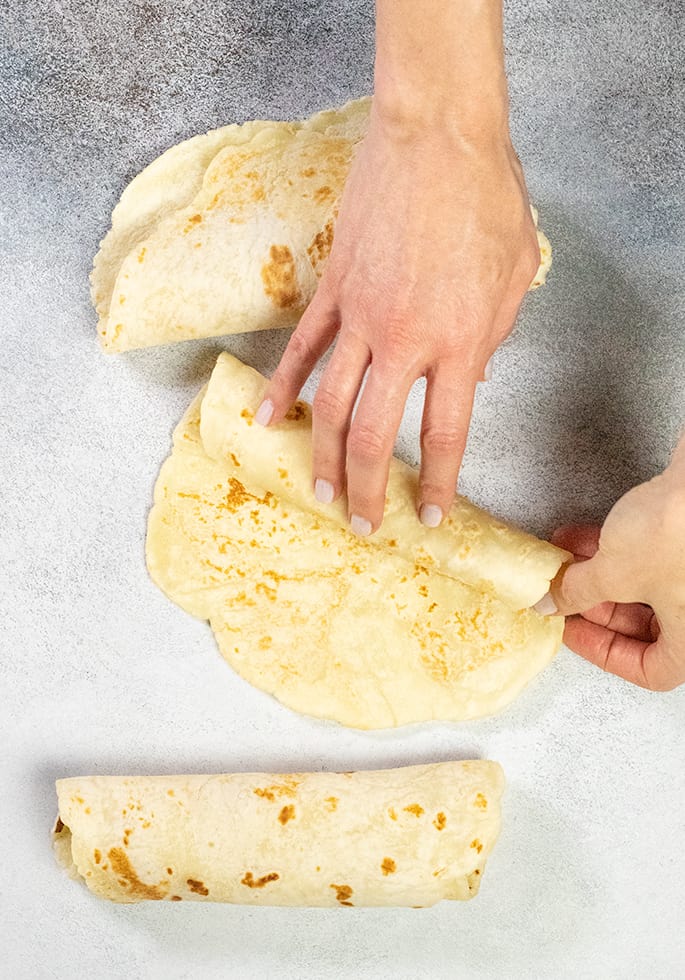
How to make gluten free flatbread
I've doubled the recipe to make 4 flatbreads for these photos, since it's easier to view the ingredients well in larger amounts. To do the same, just change the yield in the recipe card from 2 to 4.
- Whisk together the dry ingredients (flour blend, tapioca starch, baking powder, salt) in a large mixing bowl.
- Add olive oil and milk, and mix to combine.
- Let the dough sit briefly to let the flours absorb the moisture.
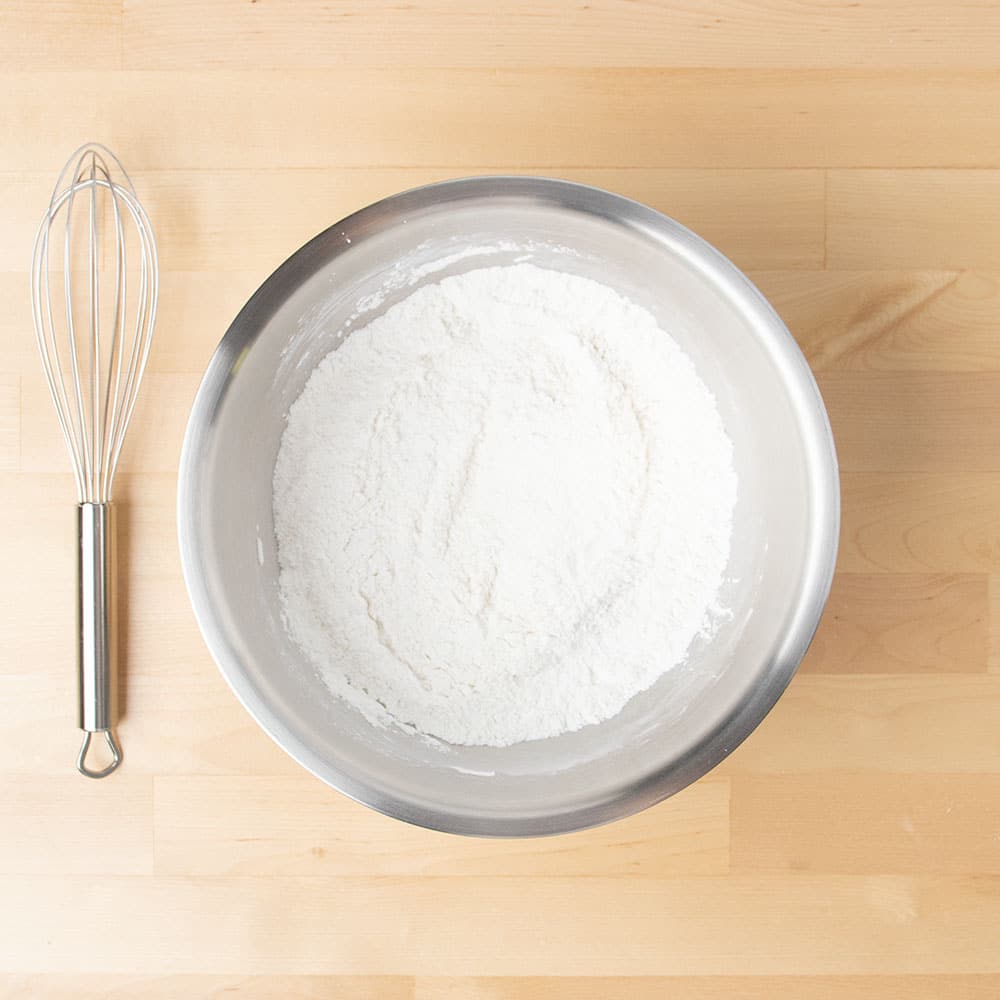

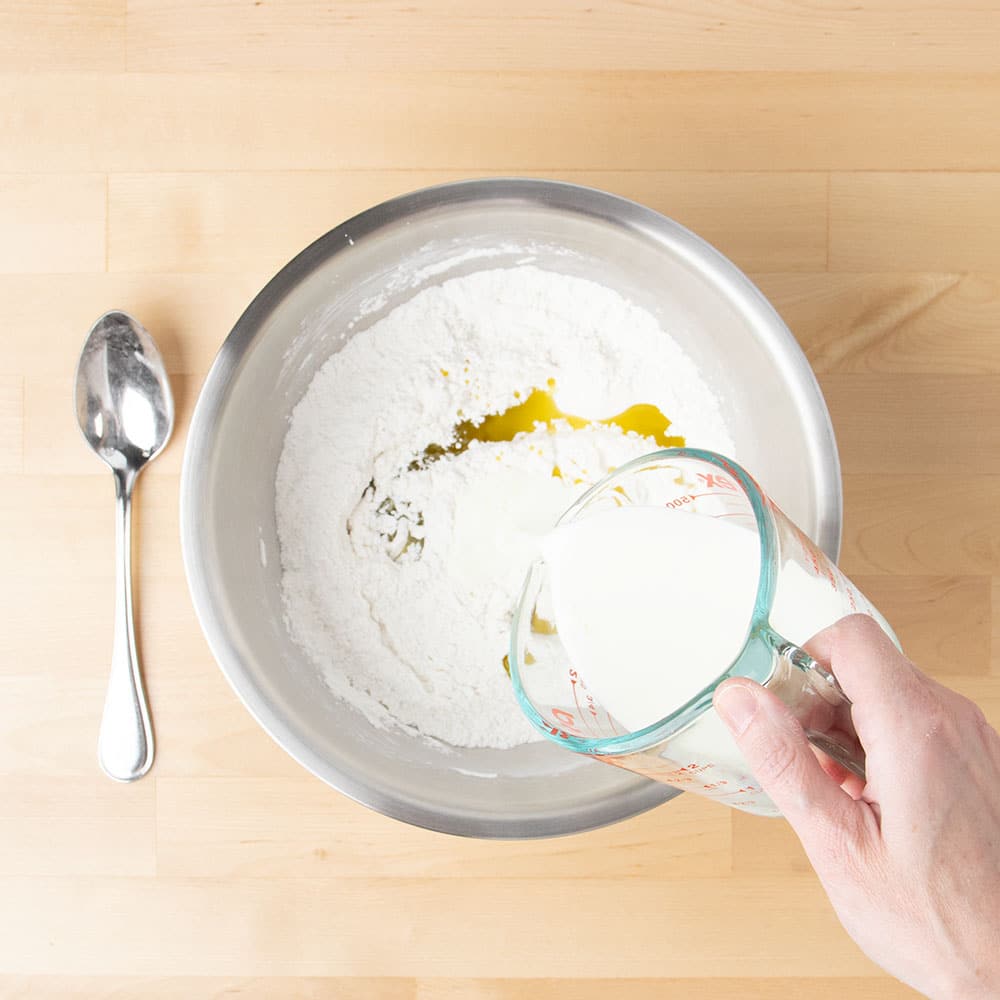
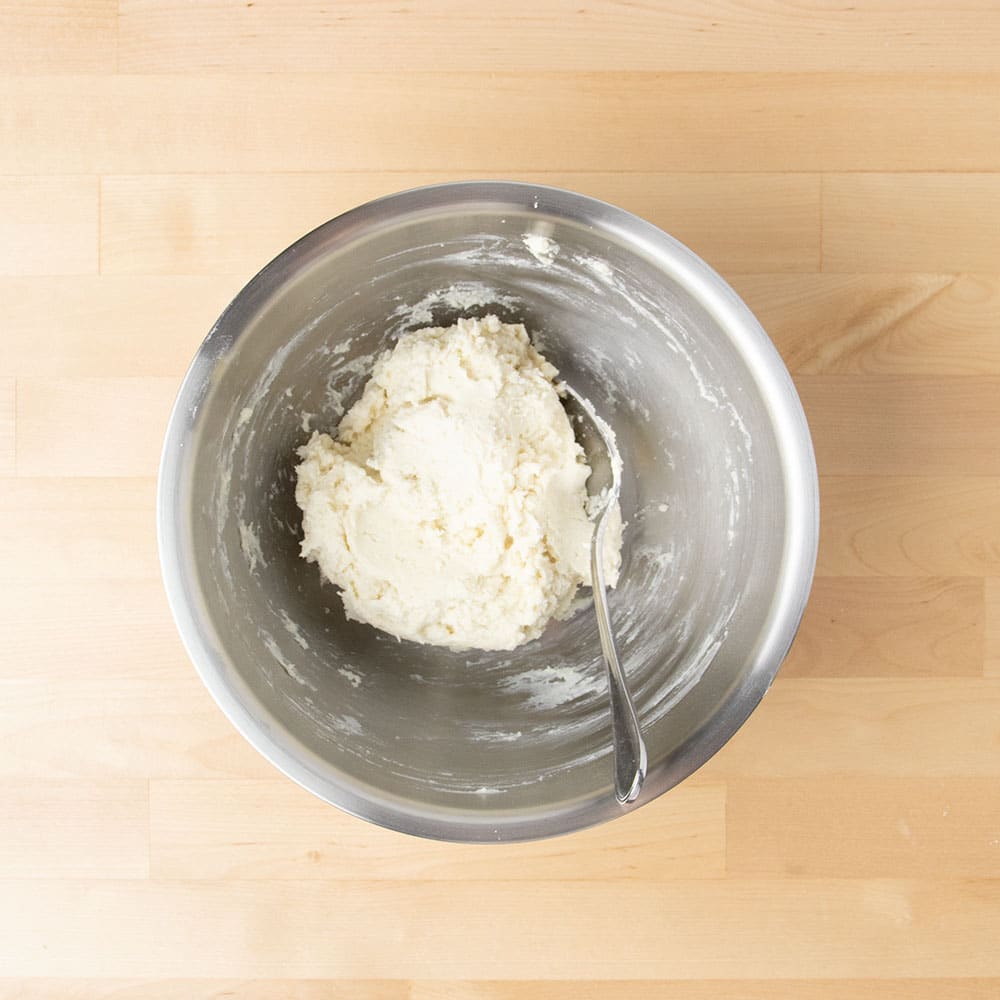
- Divide the dough into equal portions, about 5 ounces each, and wrap each portion tightly in plastic wrap.
- If you have time, chill the dough for 30 minutes in the refrigerator to make it easier to handle.
- If chilled, lightly flour the dough, roll it into a rough round, then gather it into a ball and roll again into a smooth 8-inch circle.
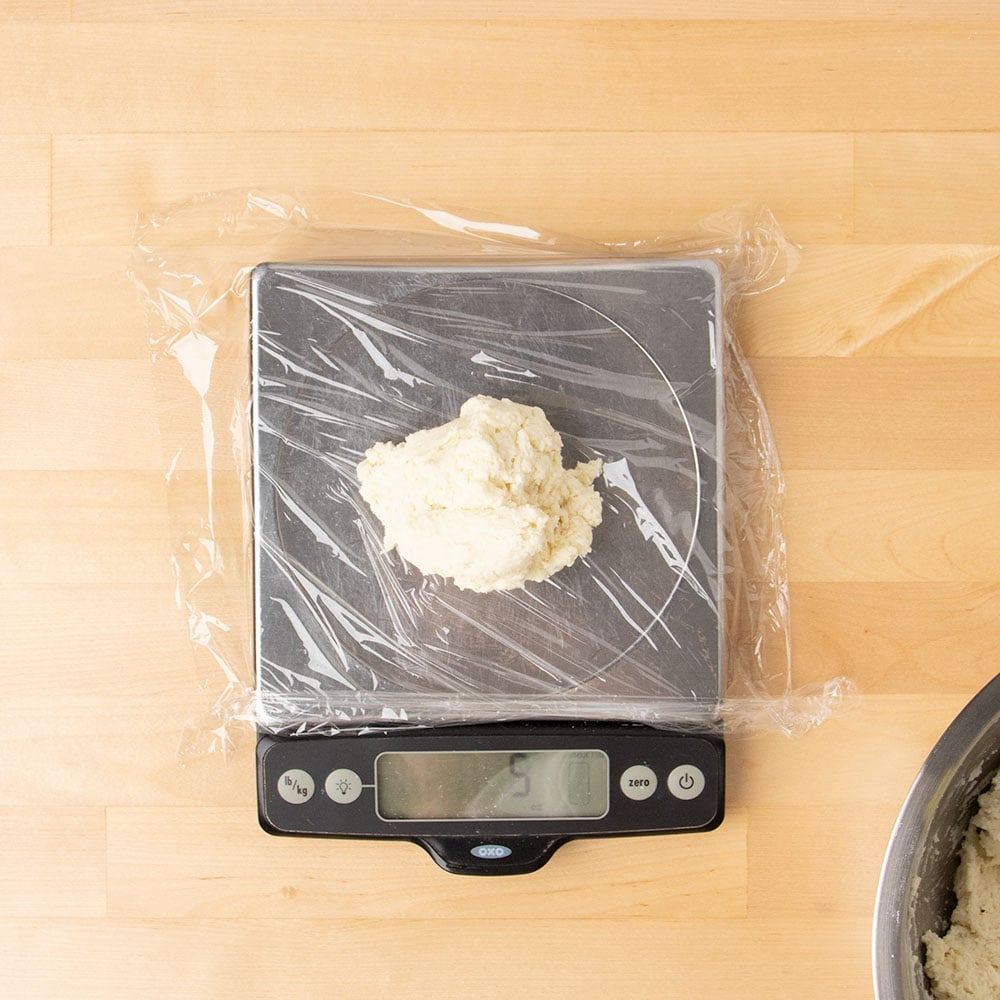



- Heat a greased skillet, place the shaped raw flatbread on it, and cook for 1 minute.
- Flip, and cook on the second side, pressing down on the bread with a large, flat spatula to make sure it makes good contact with the skillet and creates some golden brown spots.
- Flip again and cook until the surface looks dry and no longer glistens. Wrap the cooked flatbread in a tea towel to keep it warm.
- Repeat with as many flatbreads as you'd like, and serve warm.

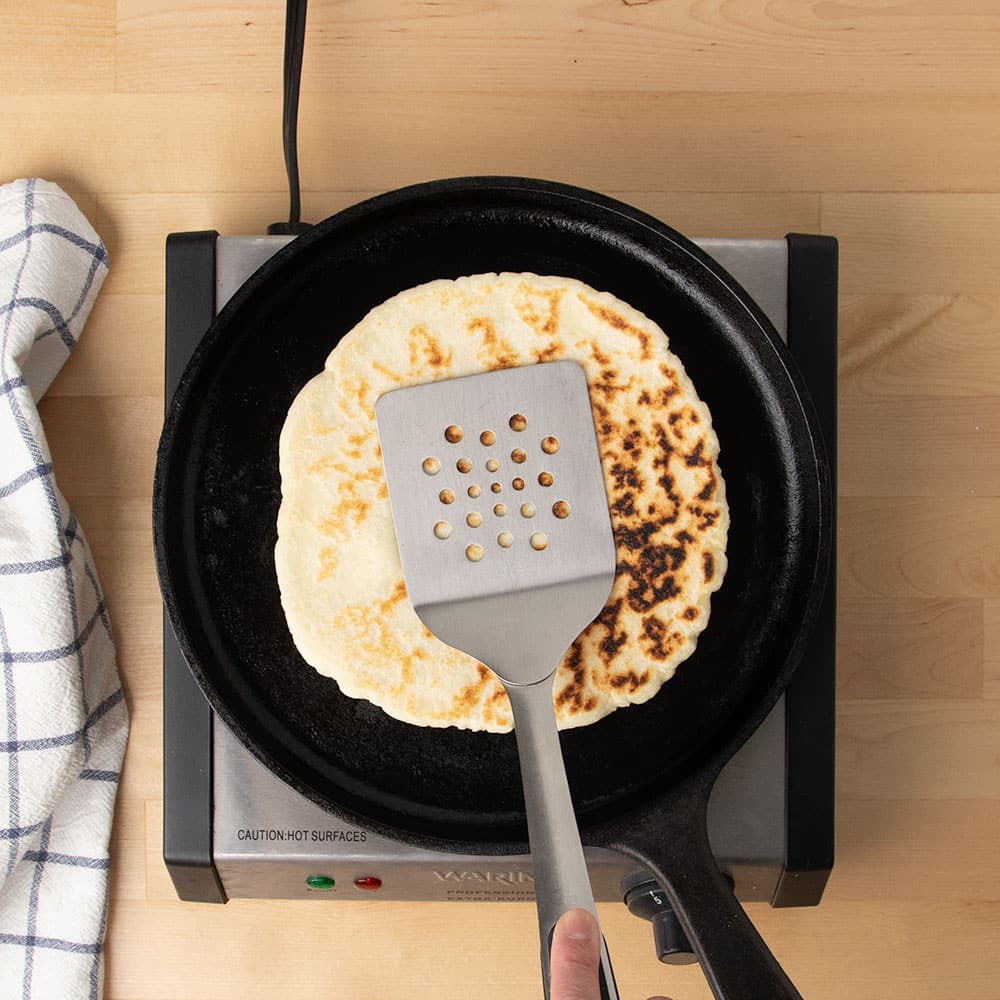
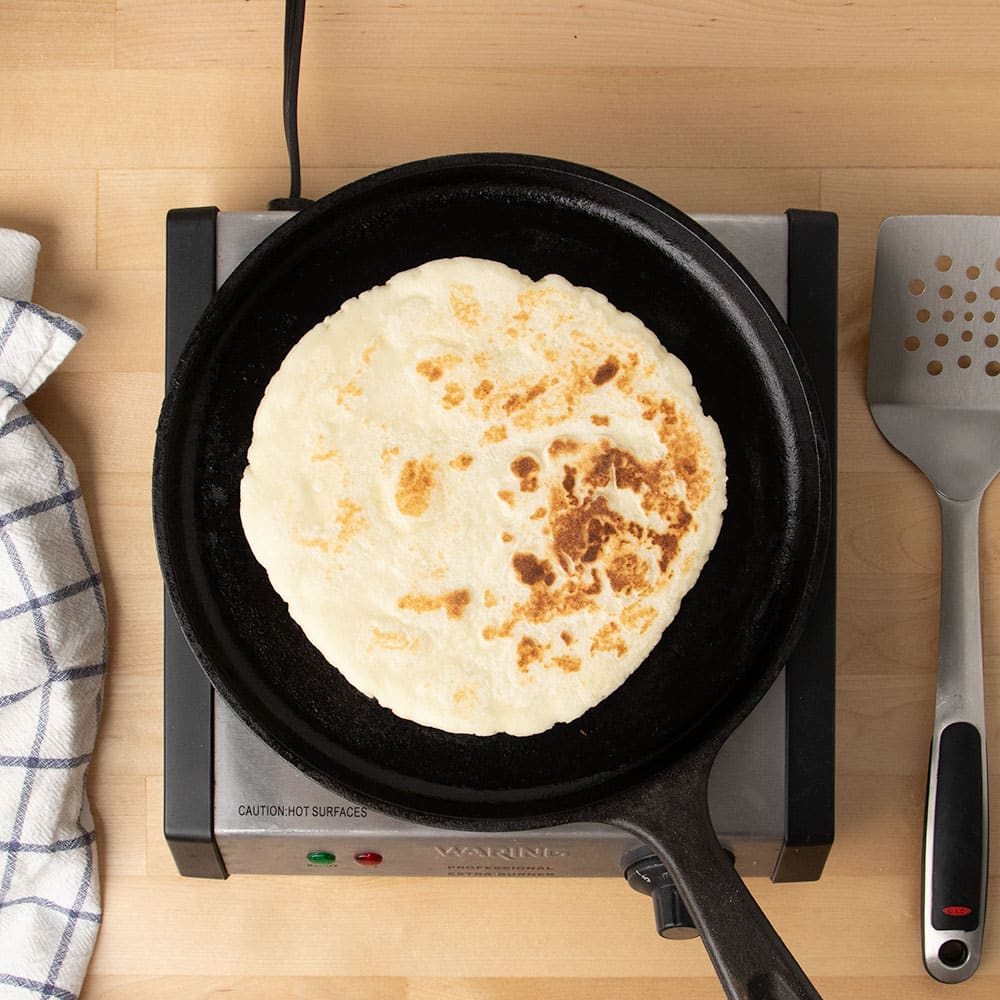

My Pro Tip
Recipe Tips
Roll when warm
Rolling flatbread while it’s still warm helps it stay flexible when cooled. It’s just like rolling a yule log or Swiss roll—warm dough ‘remembers’ the shape.
Test your skillet first
Your skillet should be hot enough to sear quickly, but not burn. Test it by cooking a small dough piece first. A cast iron skillet works best for that golden, blistered finish.

substitutions
Ingredient substitutions
The only common allergen in this recipe is dairy—and even that’s easily replaced. This flatbread is naturally egg-free.
Dairy free
Use any plain, unsweetened plant-based milk instead of dairy. I like almond milk best for flavor and texture.
Water works in place of milk, though the flatbread will be slightly less tender. It’s still soft—just not quite as rich as recipes that use yogurt, like our gluten free naan.
Tapioca starch/flour
Tapioca starch makes the dough pliable and helps create that chewy texture. In a pinch, you can try superfine glutinous (sweet) white rice flour as a substitute, though results may vary.

Gluten Free Flatbread Recipe

Ingredients
- ¾ cup (105 g) all purpose gluten free flour blend, (See Recipe Notes), plus more for sprinkling
- ½ teaspoon xanthan gum, omit if your blend already contains it
- 5 tablespoons (38 g) tapioca starch/flour, (See Recipe Notes)
- ¾ teaspoon kosher salt
- ½ teaspoon baking powder
- 1 tablespoon (14 g) extra virgin olive oil
- ½ cup (4 fluid ounces) plain unsweetened plant-based (for vegan) milk, or cow’s milk, chilled
- Neutral oil for the skillet, like grapeseed, canola, or vegetable
Instructions
Make the dough
- In a large bowl, place the flour, xanthan gum, tapioca starch/flour, salt, and baking powder, and whisk to combine well.
- Add the oil and milk, and mix to combine. The mixture will seem very wet at first, but the flour will begin to absorb the liquid quickly and the dough will become stiffer.
- If the dough doesn’t come together, knead it briefly with clean hands until smooth.
- Ideally, divide the dough into 5 ounce portions (as written, the dough makes 2 portions), wrap each tightly in plastic wrap, and chill for 30 minutes and up to 3 days. You can also work with the dough immediately, if you don’t have time to chill it.
Shape and cook the bread
- Heat a cast iron skillet that’s at least 10-inches in diameter, or a heavy-bottom nonstick skillet, over medium heat. Place a flat, wide spatula and a tea towel on the counter next to the skillet.
- If you’ve chilled the dough in portions, unwrap and work with one piece at a time. If the dough hasn’t been divided, divide it in two equal halves, each weighing about 5 ounces.
- Turn each piece of dough out onto a very lightly floured flat surface, and sprinkle lightly with extra flour. Cover the remaining dough loosely with a cloth to keep it from drying out.
- Sprinkle the dough lightly with more flour and begin to roll it into a round, sprinkling lightly with more flour as necessary to prevent sticking. The edges will be jagged and a bit rough.
- Gather the dough together and repeat the process at least once more, until the dough is smoother. Roll the dough into an approximately 8-inch round, turning and flouring lightly as necessary. The edges should be less rough, but this is rustic flatbread.
- Brush about 1 teaspoon of neutral oil on the hot skillet. Pick up the prepared raw piece of flatbread and place it flat in the center of the skillet, taking care not to bend any of the edges.
- Allow it to cook for about 1 minute without disturbing it, or until the edges begin to lift. Slide the spatula underneath the flatbread, ensuring that there are no spots that are sticking.
- Flip the flatbread over and allow it to cook for another minute, pressing it firmly back onto the skillet with the spatula to prevent it from puffing up. You can also take a toothpick and prick any bubbles to deflate them.
- Continue to cook the flatbread, flipping it frequently, until it is set on both sides and doesn’t glisten anywhere. It should take 2 to 3 minutes total.
- Remove the flatbread from the skillet, place it in the center of the tea towel, and fold the edges of the towel over on it to enclose it and keep it warm.
- Repeat with the second piece of dough, adding more oil to the skillet if needed.
To roll the flatbread
- If you'd like to roll them in a coil while they are still very warm, open the tea towel and remove both pieces of bread. Place one about 4 inches from one short end of the towel, fold the edge over the bread, and roll the bread tightly in the towel.
- Place the second flatbread on the unrolled portion of the towel, and repeat the process, rolling until the two flatbreads are tightly wrapped in the towel. Allow them to cool for at least 5 minutes wrapped in the towel before unwrapping and serving.
Video
Notes
Nutrition
Nutrition information is automatically calculated, so should only be used as an approximation.
make ahead/leftovers
Storage instructions
Wrap cooked flatbreads tightly in plastic wrap or Press’n Seal. They stay fresh at room temperature for up to 2 days.
To refresh, lightly sprinkle with lukewarm water and either microwave for 20 seconds or warm in a hot skillet for 10 seconds.
For longer storage, freeze flatbreads in freezer-safe wrap for up to 3 months. Thaw at room temp or in the microwave before refreshing.
You can also refrigerate the raw dough—portioned and wrapped—for up to 5 days. Don’t refrigerate the cooked bread, as it becomes stiff and dry.
FAQs
If the dough is too wet, add tapioca starch 1 teaspoon at a time until it’s no longer sticky.
If it’s too dry, add milk 1 teaspoon at a time, just until it comes together.
No—tapioca starch is essential here, even if it’s already in your blend. It improves dough texture, makes rolling easier, and adds chew.
Possibly! The dough is stable enough to grill if your grates are very clean and well-oiled. Try one flatbread as a test.
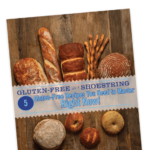
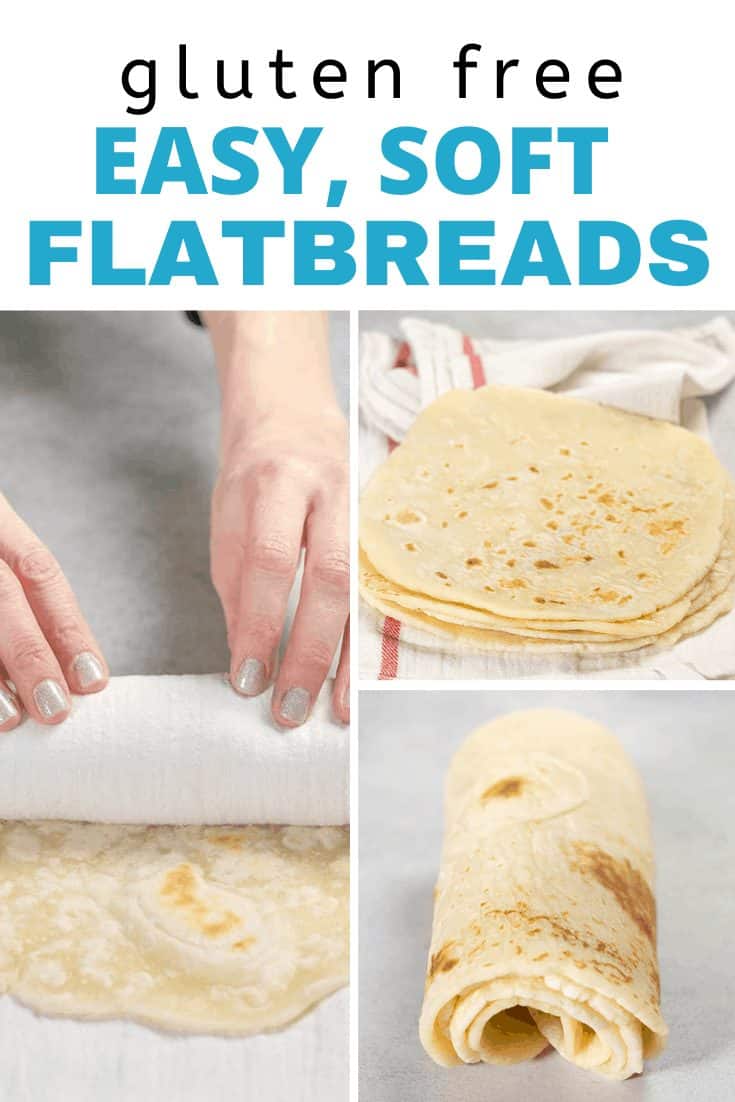
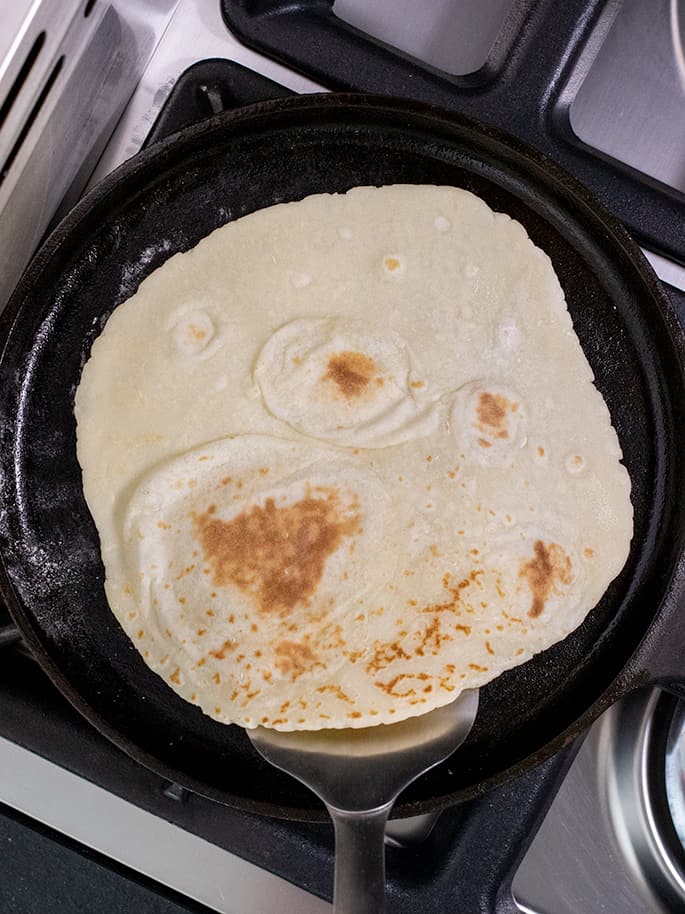

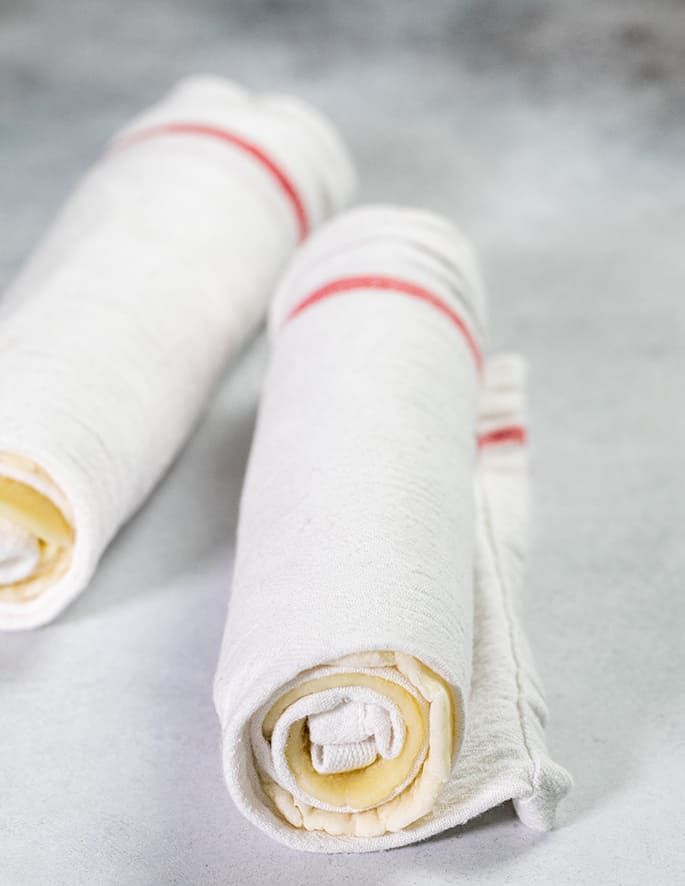


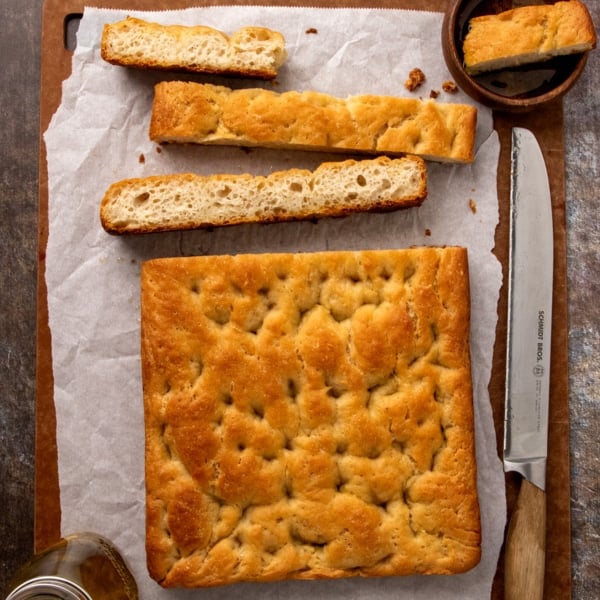
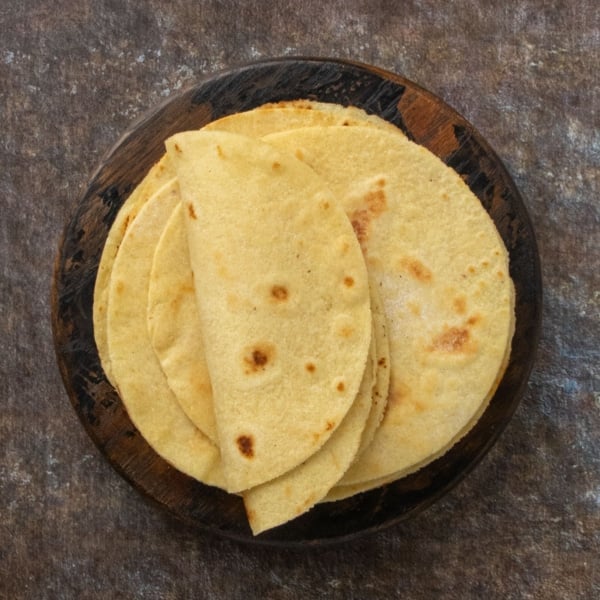
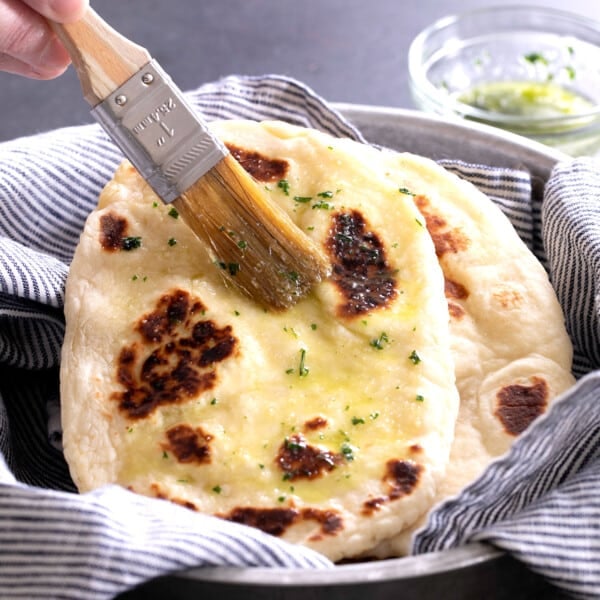
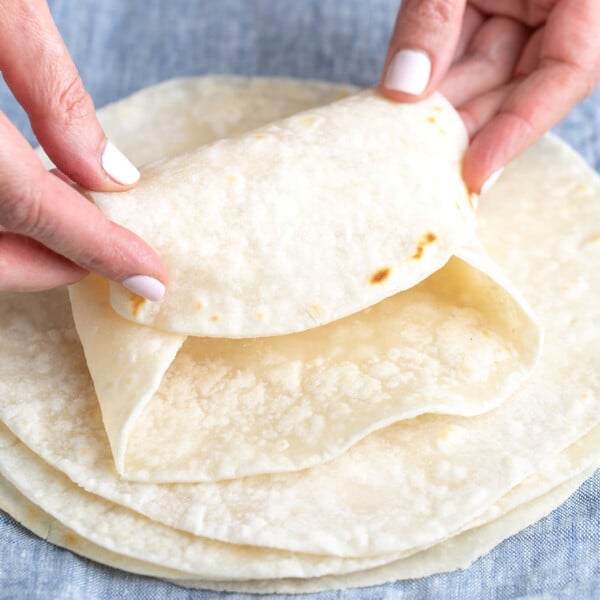









These are lovely! I’ve tried lots of others that were just dry and crumbly. I made these as directed, except I used King Arthur’s bread flour because that’s all I had. They are wonderful. Great taste, pliable and I’m sure I’ll be making them on the regular! I’ve been looking for a way to make goats cheese truffle flatbreads for a while. Thank you!
So glad to know that KAF GF Bread Flour worked well in this recipe. I honestly wouldn’t have predicted that, so I really appreciate your sharing, Kate!
I LOVE this flatbread recipe! With grocery prices going up and wages going down, I’ve been on a tight budget. I practically live on these wraps with an assortment of simple fillings. I’ve had a piadina recipe for years, with almost identical ingredients, but different measurements. I never had good results with that recipe. What was missing was the tapioca starch. It makes these wraps pliable. When I was out of my gluten free flour mixture, I’ve also used chick pea flour. I accidently bought a sizable quantity by accident. I hate the strong flavor of chick pea flour. However, I made these wraps with it, having to use twice as much flour and more for the board as chick pea flour absorbs liquids differently. Used the xanthan gum. They were perfect, without the strong flavor.
Hi, Tim, so glad you love the recipe. Gluten free recipes often have similar ingredients with much different proportions and recipe instructions, which is what I think you’re discovering. The other variable that makes a huge difference is the flour blend, and the addition of tapioca starch even to a flour blend that already contains one (as most blends do), as you’re discovering, does wonders for bread recipes. Thanks so much for sharing your experience, and I’m thrilled this recipe has loosened things up in your menu and budget!
These were so great! Easy and delicious. I’m already dreaming about the many ways I could use these, starting with a mini pizza for dinner tonight. Thanks, Nicole!
So glad you loved the flatbread, Natalie! And yes, the possibilities a endless. :)
Hi Nicole, I use Pamela’s Pancake & Baking GF Flour. Here are the ingredients: (Brown Rice Flour, White Rice Flour, Cultured Buttermilk, Almond Meal, Tapioca Starch, Sweet Rice Flour, Potato Starch, Baking Powder (Sodium Acid Pyrophosphate, Potato Starch, Sodium Bicarbonate), Baking Soda, Sea Salt, Xanthan Gum). Your FAQ says to still add Xanthum Gum even though the Pamela’s brand has it. Should I do the same and add Baking Powder even though it’s already in the flour?
I noticed you don’t use egg or yogurt like other recipes. So, would the texture be more light like naan bread or more dense? I’ve tried other recipes that turn out very heavy and dense.
Hi, Eli, I’m afraid you can’t use a pancake mix to make this recipe. This recipe calls for an all purpose gluten free flour blend, and that isn’t one. A pancake mix has all sorts of other ingredients, and we have no way of knowing how much. And just to clarify, the FAQ is not about adding extra xanthan gum, it’s about adding extra tapioca starch.
Made these for dinner. They were SO good and really easy. I didn’t realize one per person was plenty and made way too many…pretty sure they will still get eaten. Thanks for a great recipe!
You’re so welcome, Jennifer. Yes, they’re generously sized, but it really does depend on the person. For my young adult/teenage children, I make 2 per person, but regular humans only need 1. :)
Easy, super-flexible, comparatively quick.
Hi Nicole,
I cannot use tapioca flour/ starch as it is from casava plant and I cannot eat any Casava flour. Can I use Arrowroot instead of tapioca? I want to make these flat bread but not with tapioca flour. And what else can I use instead of coconut milk ,almond milk, oat milk, or rice milk as I am dairy free and don’t like or cannot tolerate these milks. Can I use water?
Please help me with the substitute milks and starches.
Thanks,
Judy
Please see the ingredient substitutions section of the text of the post for advice on replacing the milk and the starch. No you can’t use water in place of milk.